Taxation Law
VerifiedAdded on 2023/04/06
|7
|1219
|65
AI Summary
This document provides a summary of key legal issues, relevant laws, and their application to a specific case in Taxation Law. It also discusses the practical impacts of the case and addresses additional issues related to Australian residency.
Contribute Materials
Your contribution can guide someone’s learning journey. Share your
documents today.
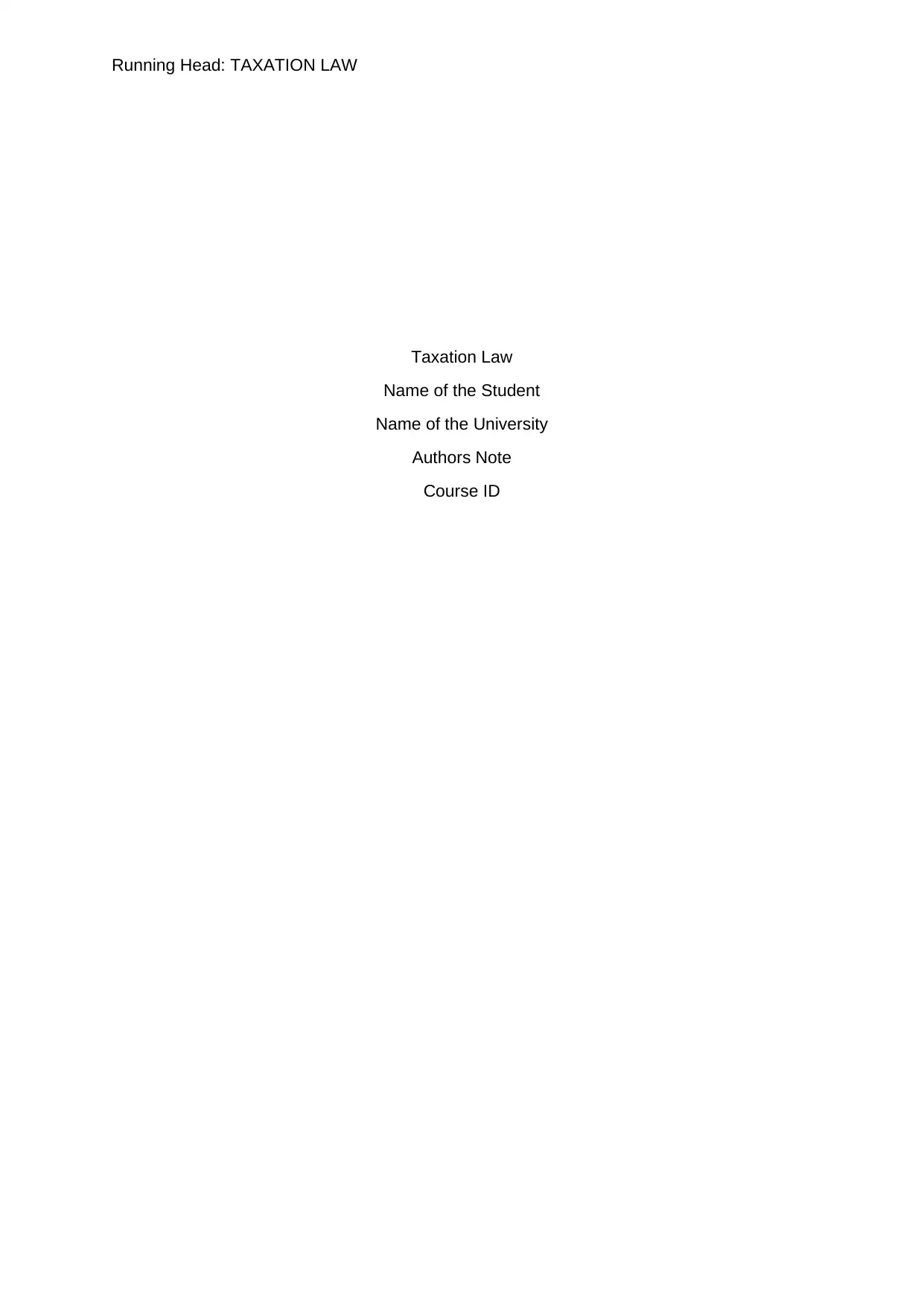
Running Head: TAXATION LAW
Taxation Law
Name of the Student
Name of the University
Authors Note
Course ID
Taxation Law
Name of the Student
Name of the University
Authors Note
Course ID
Secure Best Marks with AI Grader
Need help grading? Try our AI Grader for instant feedback on your assignments.
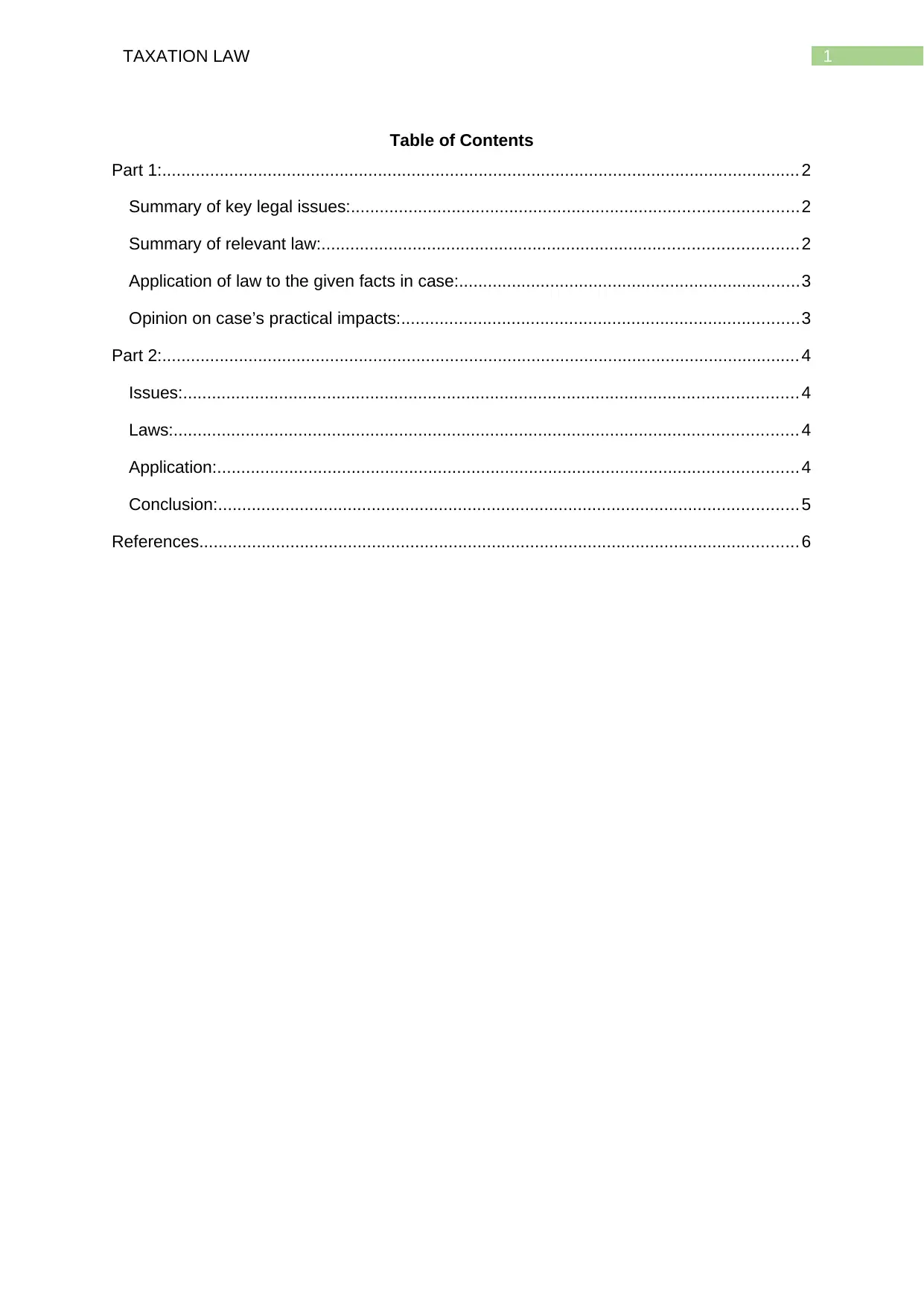
1TAXATION LAW
Table of Contents
Part 1:..................................................................................................................................... 2
Summary of key legal issues:.............................................................................................2
Summary of relevant law:...................................................................................................2
Application of law to the given facts in case:.......................................................................3
Opinion on case’s practical impacts:...................................................................................3
Part 2:..................................................................................................................................... 4
Issues:................................................................................................................................ 4
Laws:.................................................................................................................................. 4
Application:......................................................................................................................... 4
Conclusion:......................................................................................................................... 5
References............................................................................................................................. 6
Table of Contents
Part 1:..................................................................................................................................... 2
Summary of key legal issues:.............................................................................................2
Summary of relevant law:...................................................................................................2
Application of law to the given facts in case:.......................................................................3
Opinion on case’s practical impacts:...................................................................................3
Part 2:..................................................................................................................................... 4
Issues:................................................................................................................................ 4
Laws:.................................................................................................................................. 4
Application:......................................................................................................................... 4
Conclusion:......................................................................................................................... 5
References............................................................................................................................. 6
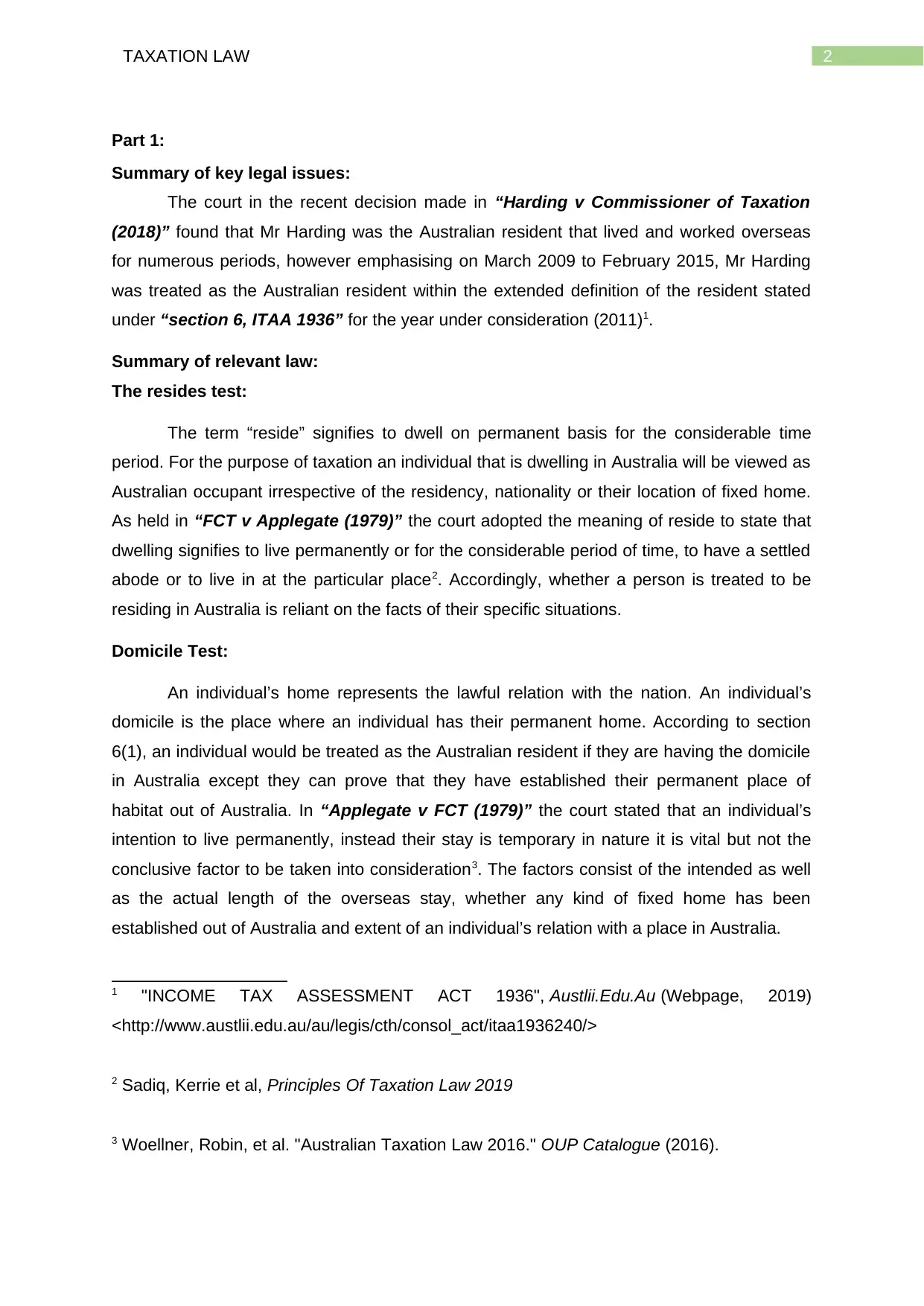
2TAXATION LAW
Part 1:
Summary of key legal issues:
The court in the recent decision made in “Harding v Commissioner of Taxation
(2018)” found that Mr Harding was the Australian resident that lived and worked overseas
for numerous periods, however emphasising on March 2009 to February 2015, Mr Harding
was treated as the Australian resident within the extended definition of the resident stated
under “section 6, ITAA 1936” for the year under consideration (2011)1.
Summary of relevant law:
The resides test:
The term “reside” signifies to dwell on permanent basis for the considerable time
period. For the purpose of taxation an individual that is dwelling in Australia will be viewed as
Australian occupant irrespective of the residency, nationality or their location of fixed home.
As held in “FCT v Applegate (1979)” the court adopted the meaning of reside to state that
dwelling signifies to live permanently or for the considerable period of time, to have a settled
abode or to live in at the particular place2. Accordingly, whether a person is treated to be
residing in Australia is reliant on the facts of their specific situations.
Domicile Test:
An individual’s home represents the lawful relation with the nation. An individual’s
domicile is the place where an individual has their permanent home. According to section
6(1), an individual would be treated as the Australian resident if they are having the domicile
in Australia except they can prove that they have established their permanent place of
habitat out of Australia. In “Applegate v FCT (1979)” the court stated that an individual’s
intention to live permanently, instead their stay is temporary in nature it is vital but not the
conclusive factor to be taken into consideration3. The factors consist of the intended as well
as the actual length of the overseas stay, whether any kind of fixed home has been
established out of Australia and extent of an individual’s relation with a place in Australia.
1 "INCOME TAX ASSESSMENT ACT 1936", Austlii.Edu.Au (Webpage, 2019)
<http://www.austlii.edu.au/au/legis/cth/consol_act/itaa1936240/>
2 Sadiq, Kerrie et al, Principles Of Taxation Law 2019
3 Woellner, Robin, et al. "Australian Taxation Law 2016." OUP Catalogue (2016).
Part 1:
Summary of key legal issues:
The court in the recent decision made in “Harding v Commissioner of Taxation
(2018)” found that Mr Harding was the Australian resident that lived and worked overseas
for numerous periods, however emphasising on March 2009 to February 2015, Mr Harding
was treated as the Australian resident within the extended definition of the resident stated
under “section 6, ITAA 1936” for the year under consideration (2011)1.
Summary of relevant law:
The resides test:
The term “reside” signifies to dwell on permanent basis for the considerable time
period. For the purpose of taxation an individual that is dwelling in Australia will be viewed as
Australian occupant irrespective of the residency, nationality or their location of fixed home.
As held in “FCT v Applegate (1979)” the court adopted the meaning of reside to state that
dwelling signifies to live permanently or for the considerable period of time, to have a settled
abode or to live in at the particular place2. Accordingly, whether a person is treated to be
residing in Australia is reliant on the facts of their specific situations.
Domicile Test:
An individual’s home represents the lawful relation with the nation. An individual’s
domicile is the place where an individual has their permanent home. According to section
6(1), an individual would be treated as the Australian resident if they are having the domicile
in Australia except they can prove that they have established their permanent place of
habitat out of Australia. In “Applegate v FCT (1979)” the court stated that an individual’s
intention to live permanently, instead their stay is temporary in nature it is vital but not the
conclusive factor to be taken into consideration3. The factors consist of the intended as well
as the actual length of the overseas stay, whether any kind of fixed home has been
established out of Australia and extent of an individual’s relation with a place in Australia.
1 "INCOME TAX ASSESSMENT ACT 1936", Austlii.Edu.Au (Webpage, 2019)
<http://www.austlii.edu.au/au/legis/cth/consol_act/itaa1936240/>
2 Sadiq, Kerrie et al, Principles Of Taxation Law 2019
3 Woellner, Robin, et al. "Australian Taxation Law 2016." OUP Catalogue (2016).
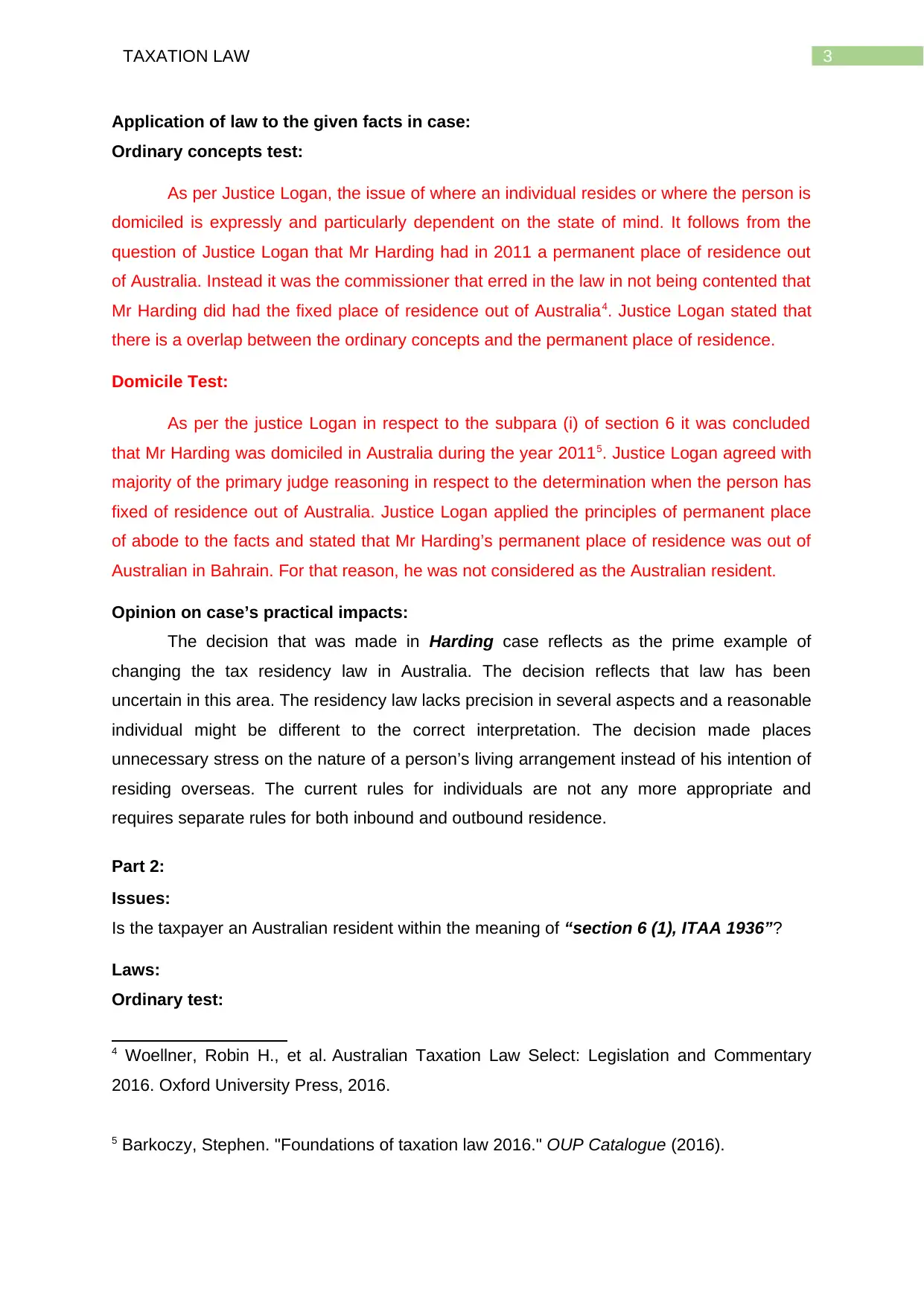
3TAXATION LAW
Application of law to the given facts in case:
Ordinary concepts test:
As per Justice Logan, the issue of where an individual resides or where the person is
domiciled is expressly and particularly dependent on the state of mind. It follows from the
question of Justice Logan that Mr Harding had in 2011 a permanent place of residence out
of Australia. Instead it was the commissioner that erred in the law in not being contented that
Mr Harding did had the fixed place of residence out of Australia4. Justice Logan stated that
there is a overlap between the ordinary concepts and the permanent place of residence.
Domicile Test:
As per the justice Logan in respect to the subpara (i) of section 6 it was concluded
that Mr Harding was domiciled in Australia during the year 20115. Justice Logan agreed with
majority of the primary judge reasoning in respect to the determination when the person has
fixed of residence out of Australia. Justice Logan applied the principles of permanent place
of abode to the facts and stated that Mr Harding’s permanent place of residence was out of
Australian in Bahrain. For that reason, he was not considered as the Australian resident.
Opinion on case’s practical impacts:
The decision that was made in Harding case reflects as the prime example of
changing the tax residency law in Australia. The decision reflects that law has been
uncertain in this area. The residency law lacks precision in several aspects and a reasonable
individual might be different to the correct interpretation. The decision made places
unnecessary stress on the nature of a person’s living arrangement instead of his intention of
residing overseas. The current rules for individuals are not any more appropriate and
requires separate rules for both inbound and outbound residence.
Part 2:
Issues:
Is the taxpayer an Australian resident within the meaning of “section 6 (1), ITAA 1936”?
Laws:
Ordinary test:
4 Woellner, Robin H., et al. Australian Taxation Law Select: Legislation and Commentary
2016. Oxford University Press, 2016.
5 Barkoczy, Stephen. "Foundations of taxation law 2016." OUP Catalogue (2016).
Application of law to the given facts in case:
Ordinary concepts test:
As per Justice Logan, the issue of where an individual resides or where the person is
domiciled is expressly and particularly dependent on the state of mind. It follows from the
question of Justice Logan that Mr Harding had in 2011 a permanent place of residence out
of Australia. Instead it was the commissioner that erred in the law in not being contented that
Mr Harding did had the fixed place of residence out of Australia4. Justice Logan stated that
there is a overlap between the ordinary concepts and the permanent place of residence.
Domicile Test:
As per the justice Logan in respect to the subpara (i) of section 6 it was concluded
that Mr Harding was domiciled in Australia during the year 20115. Justice Logan agreed with
majority of the primary judge reasoning in respect to the determination when the person has
fixed of residence out of Australia. Justice Logan applied the principles of permanent place
of abode to the facts and stated that Mr Harding’s permanent place of residence was out of
Australian in Bahrain. For that reason, he was not considered as the Australian resident.
Opinion on case’s practical impacts:
The decision that was made in Harding case reflects as the prime example of
changing the tax residency law in Australia. The decision reflects that law has been
uncertain in this area. The residency law lacks precision in several aspects and a reasonable
individual might be different to the correct interpretation. The decision made places
unnecessary stress on the nature of a person’s living arrangement instead of his intention of
residing overseas. The current rules for individuals are not any more appropriate and
requires separate rules for both inbound and outbound residence.
Part 2:
Issues:
Is the taxpayer an Australian resident within the meaning of “section 6 (1), ITAA 1936”?
Laws:
Ordinary test:
4 Woellner, Robin H., et al. Australian Taxation Law Select: Legislation and Commentary
2016. Oxford University Press, 2016.
5 Barkoczy, Stephen. "Foundations of taxation law 2016." OUP Catalogue (2016).
Secure Best Marks with AI Grader
Need help grading? Try our AI Grader for instant feedback on your assignments.
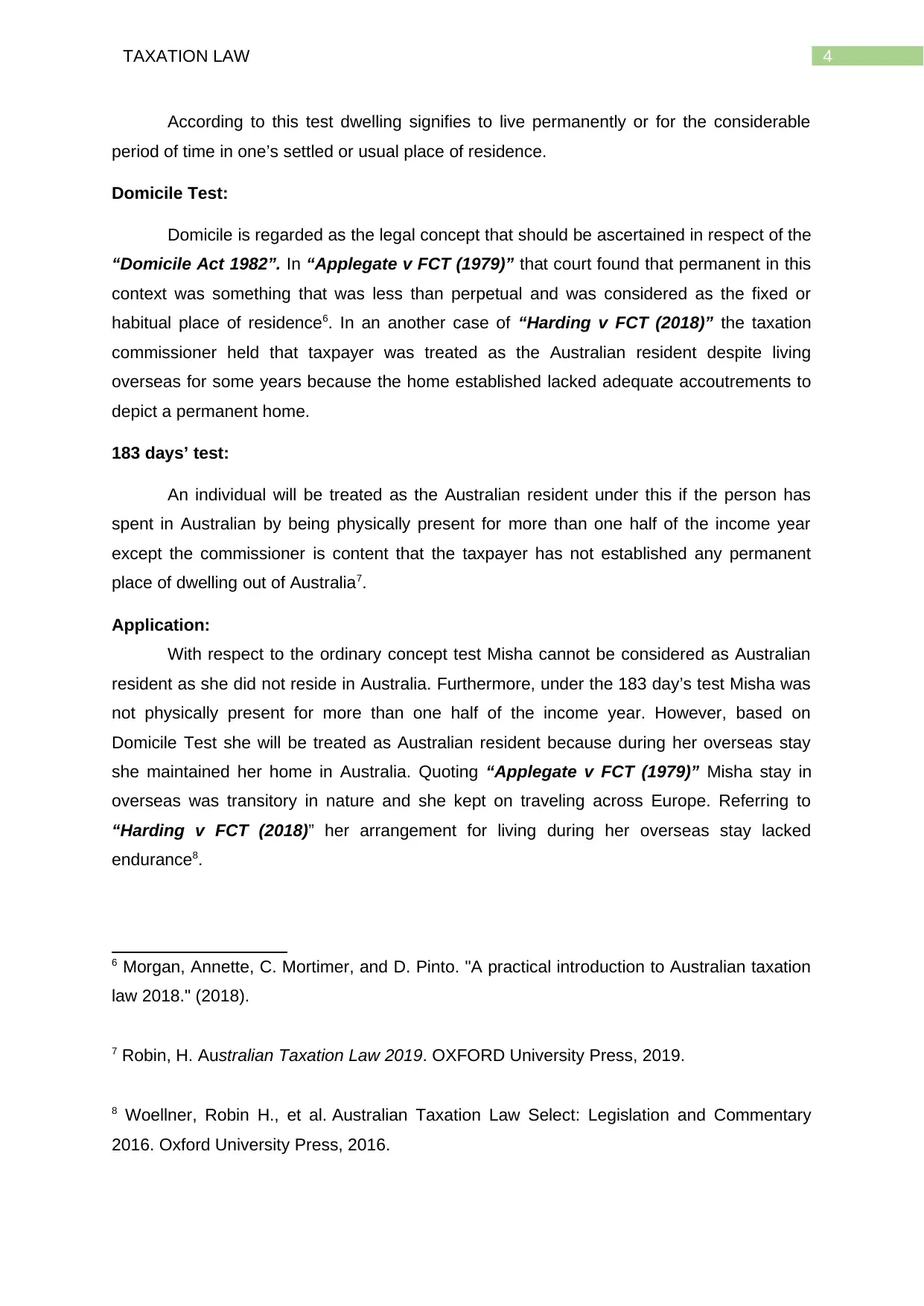
4TAXATION LAW
According to this test dwelling signifies to live permanently or for the considerable
period of time in one’s settled or usual place of residence.
Domicile Test:
Domicile is regarded as the legal concept that should be ascertained in respect of the
“Domicile Act 1982”. In “Applegate v FCT (1979)” that court found that permanent in this
context was something that was less than perpetual and was considered as the fixed or
habitual place of residence6. In an another case of “Harding v FCT (2018)” the taxation
commissioner held that taxpayer was treated as the Australian resident despite living
overseas for some years because the home established lacked adequate accoutrements to
depict a permanent home.
183 days’ test:
An individual will be treated as the Australian resident under this if the person has
spent in Australian by being physically present for more than one half of the income year
except the commissioner is content that the taxpayer has not established any permanent
place of dwelling out of Australia7.
Application:
With respect to the ordinary concept test Misha cannot be considered as Australian
resident as she did not reside in Australia. Furthermore, under the 183 day’s test Misha was
not physically present for more than one half of the income year. However, based on
Domicile Test she will be treated as Australian resident because during her overseas stay
she maintained her home in Australia. Quoting “Applegate v FCT (1979)” Misha stay in
overseas was transitory in nature and she kept on traveling across Europe. Referring to
“Harding v FCT (2018)” her arrangement for living during her overseas stay lacked
endurance8.
6 Morgan, Annette, C. Mortimer, and D. Pinto. "A practical introduction to Australian taxation
law 2018." (2018).
7 Robin, H. Australian Taxation Law 2019. OXFORD University Press, 2019.
8 Woellner, Robin H., et al. Australian Taxation Law Select: Legislation and Commentary
2016. Oxford University Press, 2016.
According to this test dwelling signifies to live permanently or for the considerable
period of time in one’s settled or usual place of residence.
Domicile Test:
Domicile is regarded as the legal concept that should be ascertained in respect of the
“Domicile Act 1982”. In “Applegate v FCT (1979)” that court found that permanent in this
context was something that was less than perpetual and was considered as the fixed or
habitual place of residence6. In an another case of “Harding v FCT (2018)” the taxation
commissioner held that taxpayer was treated as the Australian resident despite living
overseas for some years because the home established lacked adequate accoutrements to
depict a permanent home.
183 days’ test:
An individual will be treated as the Australian resident under this if the person has
spent in Australian by being physically present for more than one half of the income year
except the commissioner is content that the taxpayer has not established any permanent
place of dwelling out of Australia7.
Application:
With respect to the ordinary concept test Misha cannot be considered as Australian
resident as she did not reside in Australia. Furthermore, under the 183 day’s test Misha was
not physically present for more than one half of the income year. However, based on
Domicile Test she will be treated as Australian resident because during her overseas stay
she maintained her home in Australia. Quoting “Applegate v FCT (1979)” Misha stay in
overseas was transitory in nature and she kept on traveling across Europe. Referring to
“Harding v FCT (2018)” her arrangement for living during her overseas stay lacked
endurance8.
6 Morgan, Annette, C. Mortimer, and D. Pinto. "A practical introduction to Australian taxation
law 2018." (2018).
7 Robin, H. Australian Taxation Law 2019. OXFORD University Press, 2019.
8 Woellner, Robin H., et al. Australian Taxation Law Select: Legislation and Commentary
2016. Oxford University Press, 2016.
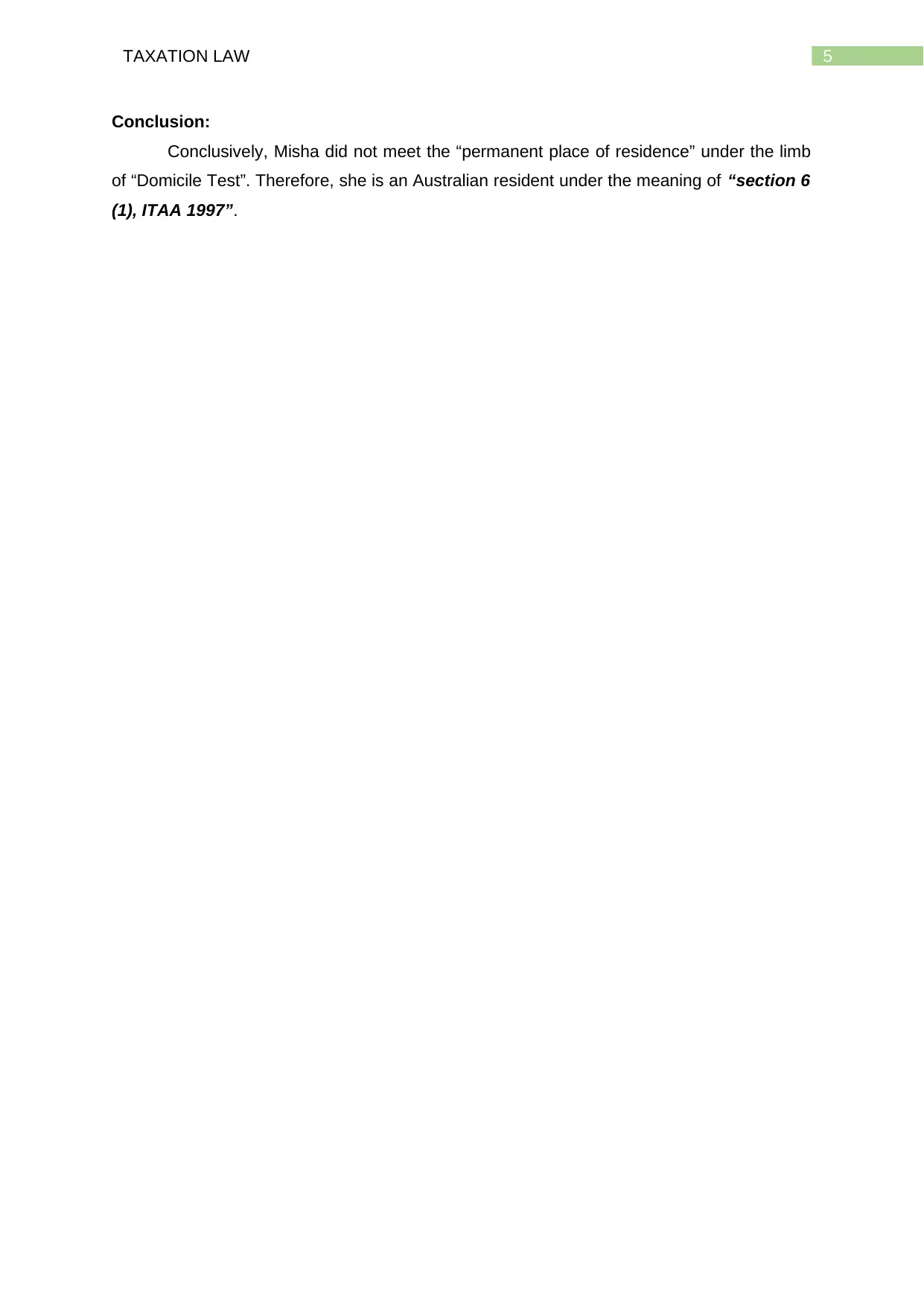
5TAXATION LAW
Conclusion:
Conclusively, Misha did not meet the “permanent place of residence” under the limb
of “Domicile Test”. Therefore, she is an Australian resident under the meaning of “section 6
(1), ITAA 1997”.
Conclusion:
Conclusively, Misha did not meet the “permanent place of residence” under the limb
of “Domicile Test”. Therefore, she is an Australian resident under the meaning of “section 6
(1), ITAA 1997”.

6TAXATION LAW
References
"INCOME TAX ASSESSMENT ACT 1936", Austlii.Edu.Au (Webpage, 2019)
<http://www.austlii.edu.au/au/legis/cth/consol_act/itaa1936240/>
"INCOME TAX ASSESSMENT ACT 1997", Austlii.Edu.Au (Webpage, 2019)
<http://www.austlii.edu.au/au/legis/cth/consol_act/itaa1997240/>
Barkoczy, Stephen. "Foundations of taxation law 2016." OUP Catalogue (2016).
Morgan, Annette, C. Mortimer, and D. Pinto. "A practical introduction to Australian taxation
law 2018." (2018).
Robin, H. Australian Taxation Law 2019. OXFORD University Press, 2019.
Sadiq, Kerrie et al, Principles Of Taxation Law 2019
Woellner, Robin H., et al. Australian Taxation Law Select: Legislation and Commentary
2016. Oxford University Press, 2016.
Woellner, Robin, et al. "Australian Taxation Law 2016." OUP Catalogue (2016).
References
"INCOME TAX ASSESSMENT ACT 1936", Austlii.Edu.Au (Webpage, 2019)
<http://www.austlii.edu.au/au/legis/cth/consol_act/itaa1936240/>
"INCOME TAX ASSESSMENT ACT 1997", Austlii.Edu.Au (Webpage, 2019)
<http://www.austlii.edu.au/au/legis/cth/consol_act/itaa1997240/>
Barkoczy, Stephen. "Foundations of taxation law 2016." OUP Catalogue (2016).
Morgan, Annette, C. Mortimer, and D. Pinto. "A practical introduction to Australian taxation
law 2018." (2018).
Robin, H. Australian Taxation Law 2019. OXFORD University Press, 2019.
Sadiq, Kerrie et al, Principles Of Taxation Law 2019
Woellner, Robin H., et al. Australian Taxation Law Select: Legislation and Commentary
2016. Oxford University Press, 2016.
Woellner, Robin, et al. "Australian Taxation Law 2016." OUP Catalogue (2016).
1 out of 7
Related Documents
Your All-in-One AI-Powered Toolkit for Academic Success.
+13062052269
info@desklib.com
Available 24*7 on WhatsApp / Email
![[object Object]](/_next/static/media/star-bottom.7253800d.svg)
Unlock your academic potential
© 2024 | Zucol Services PVT LTD | All rights reserved.





